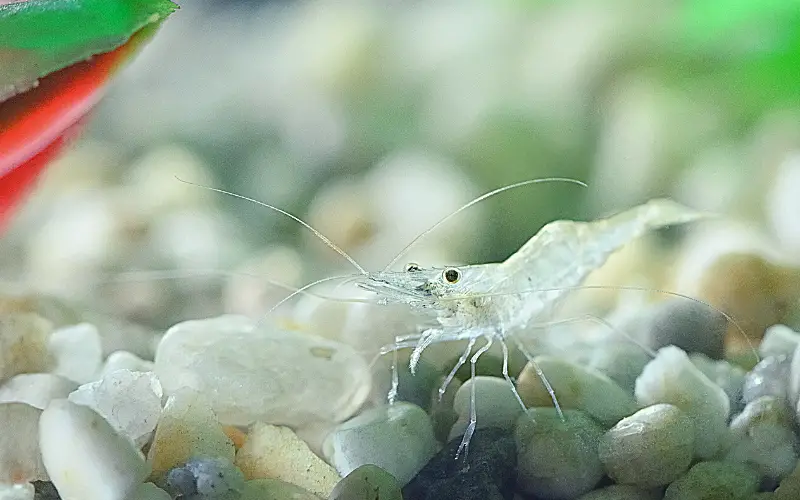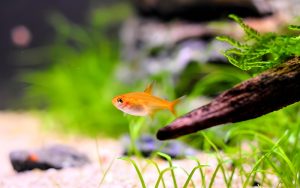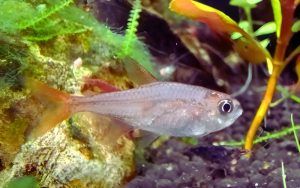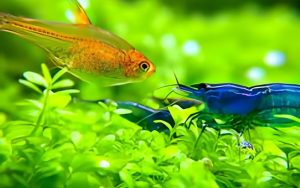Are you a proud owner of ghost shrimp in your aquarium but are puzzled and concerned as you witness their unfortunate demise? If you’ve wondered, “Why are my ghost shrimp dying?” you’ve come to the right place.
Ghost shrimp are beautiful and low-maintenance freshwater aquarium creatures but can be susceptible to death if their water quality is not ideal.
Ghost shrimp, or glass shrimp, are fascinating creatures that can bring life and vibrancy to any aquatic environment.

However, their small size and delicate nature make them susceptible to various environmental factors that can lead to their untimely demise.
By understanding the potential causes of their deaths and implementing the necessary solutions, you can create a thriving ecosystem for your ghost shrimp to thrive in.
In this definitive blog post, we will discuss five common reasons why ghost shrimp die and quick fixes you can implement to keep your ghost shrimp healthy and thriving.
So if you’re wondering why your ghost shrimp are dying, read on for answers!
Table of Contents
ToggleDo Ghost Shrimp Die Easily?
Ghost shrimp are not known to die quickly, but they can be susceptible to several problems that can lead to death if not addressed. Some of the most common causes of death in ghost shrimp include:
- Poor water quality: Ghost shrimp are very sensitive to water quality changes, and even small fluctuations in pH, ammonia, or nitrite levels can be harmful. It is essential to test your water regularly and ensure it is within the proper range for ghost shrimp.
- Overcrowding: Ghost shrimp are social creatures and do best in groups of at least six individuals. However, if you overcrowd your tank, the shrimp compete for food and space, leading to stress and death.
- Incompatible tank mates: Ghost shrimp are peaceful creatures and should not be kept with aggressive fish or invertebrates. Some aquarium fish that should be avoided include bettas, cichlids, and goldfish.
- Predators: Ghost shrimp are preyed upon by several animals, including fish, frogs, and turtles. If you have any of these animals in your tank, you must take steps to protect your ghost shrimp, such as providing them with hiding places.
- Disease: Ghost shrimp can be susceptible to some diseases, including bacterial infections and parasites. If you notice any signs of illness in your shrimp, it is important to isolate them and treat them with medication as soon as possible.
Why Are My Ghost Shrimp Dying?
Why did my ghost shrimp die so fast? Your Ghost Shrimp might be perishing due to various factors. Excessive ammonia, nitrite, heavy metals such as copper or lead, and pH levels can prove harmful. Sudden shifts in temperature, salinity, or lighting conditions can lead to fatal shock, causing imbalance and death.
Maintaining optimal water parameters and providing a stable environment is crucial to ensuring the well-being of these delicate creatures.
Top 5 Reasons why do my ghost shrimp keep dying
Insufficient Water Parameters Can Lead to Shrimp Mortality
Maintaining the correct water parameters is crucial for the health of your ghost shrimp. These tiny creatures are susceptible to changes in their environment. Factors such as ammonia levels, temperature fluctuations, and pH imbalances can spell disaster for your shrimp.
Quick Fix:
- Regularly test your shrimp tank water for ammonia, nitrites, and nitrates using reliable test kits.
- Ensure that the water tank temperature and pH levels are within the recommended range for ghost shrimp.
- If any parameter is off, take swift action to correct it to create a stable and suitable habitat for your shrimp.
Molting Process and Vulnerability
Like all crustaceans, ghost shrimp undergo a molting process where they shed their exoskeleton to grow. During this vulnerable phase, they are more susceptible to stress and aggression from tank mates. Inadequate hiding spots and aggressive tank mates toward molting shrimp can lead to fatalities.
Quick Fix: Provide plenty of hiding spots in your planted tank, such as caves and plants, where molting shrimp can take refuge. Avoid keeping aggressive or predatory fish as shrimp tank mates with your ghost shrimp during their molting period.
Overfeeding and Water Quality
Overfeeding is a common mistake among aquarium enthusiasts, and it can have dire consequences for your ghost shrimp. Uneaten food can decompose and lead to an increase in ammonia levels, jeopardizing your shrimp’s health.
Quick Fix: Feed your ghost shrimp a balanced diet of high-quality food in small quantities. Monitor the amount of food they consume and remove any uneaten food promptly. Maintaining proper water quality through regular water changes will also help prevent ammonia buildup.
Tank Mates and Compatibility
Choosing suitable tank mates for your ghost shrimp is essential to prevent stress and aggression. Some fish may see ghost shrimp as a tasty snack, leading to unfortunate casualties.
Quick Fix: Opt for peaceful and small fish species that coexist well with ghost shrimp, such as cherry or amano shrimp. Research your fish choices thoroughly and monitor their behavior to ensure a harmonious shrimp tank environment.
New Tank Syndrome and Acclimatization
They need time to acclimate to their surroundings when introducing ghost shrimp to a new tank. Sudden water chemistry or temperature changes can cause shock and stress, leading to fatalities.
Quick Fix:
- Allow newly acquired ghost shrimp to acclimate to your tank slowly.
- Use the drip acclimation method to introduce them to the water parameters in your tank gradually.
- Avoid abrupt changes that could shock your shrimp.
How Can You Tell That Your Ghost Shrimp Are Dying?
Several signs can indicate that your ghost shrimp may be dying. Being aware of these signs can help you take appropriate action to address any issues.
Here are some key indicators to look out for:
- They are not eating. Ghost shrimp are naturally voracious eaters, so if they suddenly stop eating, it could be a sign of illness or stress.
- They are swimming erratically. Healthy ghost shrimp swim in a graceful and coordinated manner. If your shrimp swim erratically or upside down, it could be a sign of a problem.
- Their colors are fading. Ghost shrimp are typically a vibrant pink or orange color. It could be a sign of illness or stress if their colors fade.
- They are missing limbs or antennae. Ghost shrimp shed their limbs and antennae as part of the molting process. However, if your shrimp are missing limbs or antennae and not molting, it could be a sign of a problem.
- They are bloated. A bloated ghost shrimp is a sign of constipation or internal parasites.
- They have white spots on their bodies. White spots on a ghost shrimp’s body signify a bacterial infection.
If you notice any of these signs, you must take action immediately to try to save your shrimp. First, check the water quality in your shrimp tank.
Ensure that the temperature, pH, and ammonia levels are within the proper range for ghost shrimp. You may also need to add a water tank conditioner to remove chlorine and chloramine from the water.
If the water quality is good, you may need to treat your shrimp for illness or parasites. There are many medications available that can be used to treat ghost shrimp. You can also improve your shrimp’s diet by feeding them various high-quality foods.
If you have taken all these steps and your shrimp are still dying, you may need to euthanize them. There are several ways to euthanize ghost shrimp, such as placing them in a cup of ice water or using clove oil.
It is important to note that it is normal for some ghost shrimp to die during the molting process. However, if you are losing a significant number of shrimp, it is a sign that there is a problem. By taking the steps outlined above, you can help to keep your ghost shrimp healthy and thriving.
How Can You Prevent Ghost Shrimp From Dying?
How do you keep ghost shrimp alive? Ghost shrimp are hardy creatures, but they may die if their water parameters are incorrect or not cared for properly. Here are some tips on how to prevent ghost shrimp from dying:
- Set up your tank correctly. Ghost shrimp need a tank with at least 10 gallons of water. The water should be dechlorinated and have a pH of 6.8-7.8. You should also add a water conditioner to remove any harmful chemicals from the water.
- Add live plants to your tank. Live plants help improve the water quality and provide hiding places for your shrimp.
- Feed your shrimp a balanced diet. Ghost shrimp can eat various foods, including flakes, pellets, and frozen foods. You should also provide them with algae wafers or other foods to help them grind their teeth.
- Avoid overstocking your tank. Overstocking your fish tank can lead to stress and poor water quality, contributing to shrimp death.
- Monitor the water parameters in your pet shrimp tank regularly. Ammonia, nitrites, and nitrates should be kept at safe levels for shrimp. You can use a tank water testing kit to check the water parameters.
- Do regular water changes. Water changes help to remove harmful chemical toxins and heavy metals from the water and keep it fresh. It would help if you did a 25% water change once a week.
- Be careful with your fish. Some fish, such as bettas and goldfish, can be aggressive towards shrimp. If you have these types of fish, you should take precautions to protect your shrimp.
By following these tips, you can help to prevent ghost shrimp from dying and keep them happy and healthy in your aquarium.
Here are some additional tips that may help:
- Avoid placing your tank in direct sunlight. This can cause the water tank temperature to rise and the water quality to deteriorate.
- Use a filter to keep the water clean. A sponge filter will help to remove debris and fish waste from the water, which can help to prevent ammonia and nitrites from building up.
- Add a heater to your tank. Ghost shrimp need the water temperature to be between 72 and 78 degrees Fahrenheit.
- Be patient. Ghost shrimp can be sensitive to environmental changes, so it may take some time to settle and thrive.
Should I Remove Dead Ghost Shrimp from My Aquarium?
If you have a tank or aquarium and notice dead ghost shrimp floating around, it is recommended to remove them promptly. Dead shrimp can release harmful toxins, such as ammonia, into the water.

Ammonia is a poisonous substance that can harm the overall health of your tank and its inhabitants. Removing the dead ghost shrimp from the tank help prevent the ammonia levels from rising and potentially damaging other aquatic life in the aquarium.
Also, leaving dead shrimp in the shrimp fish tank can create a breeding environment for bacteria and other pathogens, harming the ecosystem. Therefore, it is best to regularly monitor your tank and remove any dead ghost shrimp to maintain a healthy and balanced tank environment for your aquatic pets.
How Often Do Ghost Shrimp Molt?
The frequency of molting in ghost shrimp can vary depending on many factors, including their age, size, and environmental conditions. Generally, younger ghost shrimp molt more frequently than older ones. They may molt every few weeks or even more regularly in their early life stages.
As ghost shrimp mature and reach adulthood, the frequency of molting tends to decrease. Adult ghost shrimp may molt every few months or less frequently, depending on their growth rate and environmental factors.
It’s important to note that molting is a vulnerable period for ghost shrimp, as they are soft and unprotected until their new exoskeleton hardens. During this time, they may hide or become less active to avoid potential predators.
If you are keeping ghost shrimp as pets, providing them with a proper environment that includes hiding places, such as caves or plants, can help them feel secure during the molting process. Additionally, maintaining good water quality and a balanced diet can contribute to the ghost shrimp’s healthy molting and overall well-being.
NOTE: If you have many ghost shrimp in your aquarium, you must know that they may start to reproduce, so you should be ready for that. During the breeding phase, the male shrimps can exhibit assertive behavior and show particular interest in the female shrimps.
Even though ghost shrimps are small creatures and require small tank sizes, it is disheartening that some individuals still overcrowd their tanks.
Common FAQs About Ghost Shrimp Health & Tank Water Parameters
How long do ghost shrimp typically live?
Ghost shrimp have a lifespan of around 1 to 1.5 years in optimal conditions.
Can I keep ghost shrimp with fish?
You can, but choose peaceful fish species that won’t kill the shrimp.
Why do some ghost shrimp have a white ring around them?
Why does my ghost shrimp keep dying? The “white ring of death” signifies that a ghost shrimp died during molting.
Are ghost shrimp sensitive to water changes?
Yes, ghost shrimp are highly sensitive to sudden water chemistry and temperature changes.
Can I feed my ghost shrimp the same food as my fish?
Ghost shrimp require specialized shrimp food that meets their nutritional needs.
How can I tell if my ghost shrimp is molting?
A molting ghost shrimp will appear more opaque and lazy as it sheds its exoskeleton.
What is ammonia and how does it affect ghost shrimp?
Ammonia is a venomous compound that can build up in the tank due to waste produced by fish in the aquarium. Ghost shrimp are very sensitive to high levels of ammonia, and it can quickly lead to their death.
How should I keep ghost shrimp to ensure their well-being?
To keep ghost shrimp healthy, having a well-maintained shrimp tank is essential. This means monitoring water parameters and providing suitable tank mates. Additionally, supplying the right food and creating a suitable habitat for them is vital.
Can the presence of other fish in the aquarium cause ghost shrimp death?
Yes, some fish may pose a threat to ghost shrimp. Certain species of fish may eat ghost shrimp, leading to their death. It is essential to choose compatible tank mates for ghost shrimp.
What should I feed my ghost shrimp?
Ghost shrimp are omnivorous and will eat a variety of foods. You can feed them specialized shrimp pellets, algae wafers, blanched vegetables, and even trim live foods like daphnia or brine shrimp.
What is the white ring of death in ghost shrimp?
The white ring of death is a condition where a ghost shrimp develops a white or cloudy ring around its body. This is often a sign of poor water quality or stress, indicating an underlying issue that may lead to the shrimp’s death.
How should I go about placing ghost shrimp in my tank?
When introducing ghost shrimp to your tank, it is essential to acclimate them slowly to the new water conditions. You can do this by floating the bag the shrimp came in on the tank’s surface, allowing the temperatures to equalize before releasing them.
How can I prevent ghost shrimp from dying in my aquarium?
To prevent the death of ghost shrimp in your aquarium, ensure that the water parameters are suitable for them, maintain good water quality, provide adequate hiding places, and choose suitable tank mates. Regularly observe the health and behavior of your shrimp to catch any issues early on.
Why do ghost shrimp die in aquariums?
Ghost shrimp can die in aquariums for various reasons, including poor water conditions, inadequate food supply, incompatible tank mates, or underlying health issues. Providing the proper shrimp care and needs is essential for them to thrive.
Can certain factors kill ghost shrimp in a tank?
Yes, certain factors can kill ghost shrimp in a tank. High levels of ammonia or nitrites, sudden changes in water parameters, aggressive tank mates, and lack of suitable hiding places can all contribute to the death of ghost shrimp.
Should I quarantine new shrimp before adding them to my tank?
Yes, it is recommended to quarantine new shrimp before adding them to your tank. This helps prevent the introduction of diseases or parasites that may harm the existing shrimp. Quarantine tanks should have similar water conditions and be adequately cycled to avoid stress on the shrimp.
Why are all my ghost shrimp dying?
Ghost shrimp may die due to poor water quality, inadequate diet, or stress. Ensure proper water parameters, provide a balanced diet, and create a suitable habitat. Regular maintenance, water changes, and monitoring can help maintain a healthy environment for ghost shrimp.
Conclusion
So, why are my ghost shrimp dying? Keeping ghost shrimp healthy and thriving in your aquarium requires attention to detail and a deep understanding of their needs. By addressing potential issues such as water parameters, molting vulnerabilities, overfeeding, tank mate compatibility, and acclimatization, you can create a safe and comfortable nurturing environment for these intriguing creatures. Remember, a little care goes a long way in ensuring the well-being of your ghost shrimp population, allowing you to enjoy their mesmerizing presence in your tank for years to come.
You might also like
- Dead Ghost Shrimp Disaster: 1 Remarkable Molting Comeback!
- How Often Do Ghost Shrimp Molt: (A Comprehensive Guide)
- Do Shrimp Need a Heater: 3 Surprising Benefits of Warm Water
- Do Shrimp Die After Laying Eggs? (Discover the Truth!)
- Do Ghost Shrimp Need a Filter? A Comprehensive Guide
- How Long Do Ghost Shrimp Live: (Prolong Their Lifespan)
- Ghost Shrimp Life Span 101: Excellent Tips You Can’t-Miss
- Can Ghost Shrimp Breed with Cherry Shrimp: (Shocking Answer)
- How Many Ghost Shrimp in a 5 Gallon Tank: A Detailed Answer
- How Many Ghost Shrimp in a 10 Gallon Tank: A Detailed Guide
- Can Red Cherry Shrimp Live with Ghost Shrimp: A Detailed Answer!
- Best Water Temp for Cherry Shrimp: The 72°F Secret Breeding Success
- Are Ghost Shrimp Good Algae Eaters: (You’ll Be Surprised)
- Ghost Shrimp Parasites: 3 Quick Fixes for Horsehair Worms!





